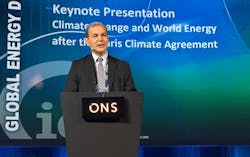Oil and Gas at the Technology Crossroads
The bi-annual ONS event in Stavanger, Norway, is one of the largest oil and gas industry conferences in the world with more than 1,400 exhibitors and nearly 100,000 attendees. Though this was my first visit to the event, there was a palpable sense of change in the air. I use the word “palpable” (i.e., able to be touched or felt) not in any sense of journalistic hyperbole, but because change in the oil and gas industry was all everyone at the show seemed to be talking about.
One session, in particular, seemed to sum up the driving factors behind this overarching sense of change. Featuring speakers from the International Energy Agency (IEA), Statkraft, DNV GL, and Exelon — as well as a futurist — both the current realities and near-term possibilities related to the inevitable changes in oil and gas were discussed.
Kamel Ben Naceur, director of the IEA, kicked off the session by highlighting the most salient points driving the oil and gas industry through its biggest changes in years. These issues include:
- This is the first time in three decades there has been no recovery in oil prices for two straight years (2015 and 2016). Naceur says he does not see any recovery in prices until at least the second half of 2017 when supply is projected to fall below demand.
- CO2 emissions have been flat since 2014. This is the first time this has happened in the last four decades in the absence of a significant global economic decline. In fact, this flattening of CO2 levels has occurred during a time when global GDP has been growing at an average of 3.5 percent.
- Renewable (hydro, solar, wind) power prices have dropped nearly in half over past four years, resulting in a steep increase in investments in this sector. Naceur pointed to a 40 percent drop over the past few years in the cost of land-based wind energy as an example. A recent report from Lawrence Berkeley National Laboratory shows that U.S. solar power costs have dropped 70 percent since 2009.
Such realities supported comments from other speakers, such as Remi Eriksen, group president and CEO of energy industry advisor DNV GL, who said: “The golden age of gas some had predicted has failed to materialize; oversupply looms large for the next few years at least.”
Expanding on Eriksen’s comments, Christian Rynning-Tonnesen, CEO of energy company Statkraft, said: “The future clearly calls for more energy, but less carbon. Renewable global electricity production is at 22 percent today, and will be between 42 percent and 55 percent by 2035. Based on technology advances alone, over the next 20 years we will see wind power costs decrease by 20 percent and solar power will decrease by 40 percent.” He also noted that the trends around renewable energy sources have led investments in renewables to now equal investments being made in upstream oil and gas.
The tone of the discussion in this session clearly changed when Chris Crane, president and CEO of U.S. energy company Exelon, took the stage. Citing the need for “carefully balanced national energy policy,” Crane pointed out that he thinks public policy has a potentially bigger effect on the future of the energy industry than any specific technology advances.
In his presentation, Crane referenced energy policy initiatives, such as those being implemented in California (e.g., SB 350), as being out of line with the realities of energy production and delivery. Public policy should “not focus on technologies or methods,” he said, “but on outcomes.”
Highlighting the inevitable change all industries face at one time or another—and which oil and gas is facing now—futurist Stefan Hyttfors reminded everyone about how Kodak missed the digital future of picture taking, even though one of their engineers helped create it. Companies like Kodak don’t necessarily disappear because they did anything “bad or stupid,” he said. “They just happened to be the best at creating something we don’t need or want anymore.”
Hyttfors indicated that this is the problem facing oil and gas today. Citing the public clamor for new, cleaner technologies—as evidenced by the hundreds of thousands of people willing to put up a deposit for a new Tesla car they haven't even seen yet—Hyttfors said, “The only way to create more value with less resources is to go with technology, not commodities. Renewable energies are technologies, not commodities. Oil and other fossils fuels will die because they will be replaced with technology.”
Underscoring his comments, and seemingly in response to Crane’s position about public policy being more influential than technology, Hyttfors added, “Politics doesn't matter in this transition because technology is borderless. It’s impossible to defend against technology by building walls. You won’t stop the advance of technology; it will just happen elsewhere.”
About the Author
David Greenfield, editor in chief
Editor in Chief

Leaders relevant to this article:
